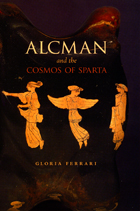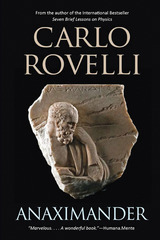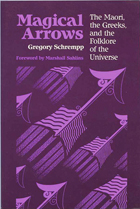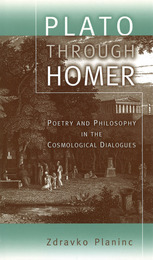4 books about Cosmology, Ancient

Alcman and the Cosmos of Sparta
Gloria Ferrari
University of Chicago Press, 2008
The Partheneion, or “maiden song,” composed in the seventh century BCE by the SpartanpoetAlcman, is the earliest substantial example of a choral lyric. A provocative reinterpretation of the Partheneion and its broader context, Alcman and the Cosmos of Sparta excavates the poem’s invocations of widespread and long-lived cosmological ideas that cast the universe as perfectly harmonious and invested its workings with an ethical dimension.
Moving far beyond standard literary interpretations, Gloria Ferrari uncovers this astral symbolism by approaching the poem from several angles to brilliantly reconstruct the web of ancient drama, music, religion, painting, and material culture in which it is enmeshed. She shows, for example, that by stringing together images of horses, stars, and birds, the poem evokes classical antiquity’s beloved dance of the constellations. Instrumental in shaping the structure of the lyric, this dance symbolizes the cosmic order reflected in the order of the state, which the chorus would have enacted in a ritual performance of the song.
With broad implications for archaeology, art history, and ancient science, Ferrari’s bold new analysis dramatically deepens our understanding of Greek poetry and the rich culture of archaic Sparta.
[more]

Anaximander
Carlo Rovelli
Westholme Publishing, 2011
THIS BOOK IS NO LONGER AVAILABLE.
[more]

Magical Arrows
The Maori, The Greeks, And The Folklore Of The Universe
Gregory A. Schrempp
University of Wisconsin Press, 1992
A fascinating and sophisticated exploration of cosmology, Magical Arrows connects the Western philosophical tradition with the cosmological traditions of non-Western societies, particularly those of Polynesia. Using the mythology and philosophy of the Maori of New Zealand as a counterpoint to Western thought, Schrempp finds a philosophical common denominator in the thought of the pre-Socratic philosopher, Zeno of Elea. Schrempp suggests that the paradoxes of Zeno, together with the philosophical speculations that they have historically inspired, contain sophisticated insights which are nevertheless general enough to form the foundations of a comparative cosmology.
Schrempp suggests that perhaps the most noteworthy Zenoian insight is that paradox is intrinsic to cosmological speculation. But he points out that there are many other characteristics of Zeno’s approach, including the strategy of juxtaposing concrete images to mathematical forms of representation, that reappear persistently in Western intellectual history. Schrempp proceeds through a series of juxtapositions—between Zeno, Kant, Lovejoy, and Lévi-Strauss, and between Western cosmologists and those from other cultures—to highlight subtle similarities and differences among intellectual traditions and to examine the conceptual apparatus of Western social science.
Schrempp concludes that a meaningful comparative cosmology is possible and that the tradition of Zeno provides a propitious starting point for such a perspective.
Schrempp suggests that perhaps the most noteworthy Zenoian insight is that paradox is intrinsic to cosmological speculation. But he points out that there are many other characteristics of Zeno’s approach, including the strategy of juxtaposing concrete images to mathematical forms of representation, that reappear persistently in Western intellectual history. Schrempp proceeds through a series of juxtapositions—between Zeno, Kant, Lovejoy, and Lévi-Strauss, and between Western cosmologists and those from other cultures—to highlight subtle similarities and differences among intellectual traditions and to examine the conceptual apparatus of Western social science.
Schrempp concludes that a meaningful comparative cosmology is possible and that the tradition of Zeno provides a propitious starting point for such a perspective.
[more]

Plato through Homer
Poetry and Philosophy in the Cosmological Dialogues
Zdravko Planinc
University of Missouri Press, 2003
This new study challenges traditional ways of reading Plato by showing that his philosophy and political theory cannot be understood apart from a consideration of the literary or aesthetic features of his writing. More specifically, it shows how Plato’s well-known cosmological dialogues—the Phaedrus, Timaeus, and Critias—are structured using several books of the Odyssey as their shared source text.
While there has recently been much scholarly discussion of the relation between poetry and philosophy in Plato’s dialogues, little of it addresses questions central to thoroughgoing literary criticism. Planinc’s work is unique in that it shows the significance of Plato’s extensive refiguring of key episodes in the Odyssey for an interpretation of his political philosophy.
Plato’s cosmological dialogues are almost always discussed topically. The Timaeus is picked through for its theological or scientific doctrines; the Critias is reduced to its Atlantis story, or puzzled over because of its ostensible incompleteness; and the Phaedrus is read for its parallels to modern understandings of erotics or rhetoric. The dialogues are not usually considered in relation to one another, and then only in the context of developmental schemes primarily concerned with distinguishing periods in Plato’s metaphysical doctrines.
Planinc argues that the main literary features of the Phaedrus,Timaeus, and Critias are taken from books 6 to 9 of the Odyssey, the largest part of the story of Odysseus’s stay with the Phaeacians, from the time he swims to shore and encounters Nausicaa to the time he reveals his identity and begins recounting his earlier travels after hearing Demodocus’s songs. By exploring the full range of the many charming and intriguing things the dialogues present in this literary context, he shows that they are a coherent, unified part of Plato’s corpus.
Plato through Homer takes a radically new approach to Plato’s texts that illuminates their literary and philosophic significance and highlights their enduring appeal.
[more]
READERS
Browse our collection.
PUBLISHERS
See BiblioVault's publisher services.
STUDENT SERVICES
Files for college accessibility offices.
UChicago Accessibility Resources
home | accessibility | search | about | contact us
BiblioVault ® 2001 - 2024
The University of Chicago Press









